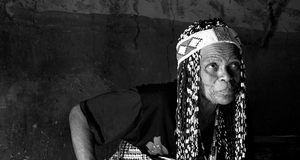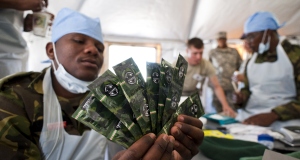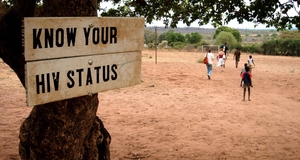A High Standard of Living, Brought Low by AIDS in South Africa
By
2010, Vol. 2 No. 01 | pg. 2/2 | « Between 1994 and 1996, the RDP financed “free medical care for under-six children and pregnant mothers, a school feeding programme [sic], electrification of poor homes and public works projects for unemployed youths” using a several billion rand budget.14 From 1996 to 2000, RDP achievements included “4 million more people given access to clean running water,” 0.9 million housing projects built and 1.1 million housing subsidies distributed, 1.5 million new electrical and 4.2 million new telephone hookups, 3 billion rand spent on “poverty relief,” 600 new health clinics, and the realization of free health care for all pregnant women and children under six.15 South Africa's hunger rate dropped to 2% by 2007.16Overall, 90% of South Africa's welfare budget is spent on social security, but the government attempts to reconcile this imbalance by also offering up to 60% of financing to non-governmental organizations (NGOs) involved in social welfare and/or charity, like the Child and Family Welfare Society.17 South Africa still has a long way to go in order to provide a decent standard of living for all of its citizens. In the CIA's Gini index calculations of income disparity, last updated on 4 December 2008, South Africa had the largest gap between rich and poor of all the countries surveyed, with a coefficient of 65.18 The South African government allocated 50.7 billion rand to education in 2001, one of the largest single expenditure items, and 14.8% of the total budget went to education, nutrition, and health care combined; health care spending increased from 24.8 billion rand in 1997 to 32.3 billion four years later, with the Ministry of Health's universal immunization campaign at the forefront.19 Nonetheless, 19 million South Africans still had no health insurance in 2001, and only about 56% of health clinics have the equipment and facilities to test for HIV/AIDS. Like in many more developed Western countries as well, South Africa has a devastating shortage of trained personnel, especially teachers, hospital staff, and social workers, which offsets the substantial budgetary outlays for welfare reforms. In a General Household Survey conducted in 2007 by the South African government, 87.8% of the population indicated satisfaction with services in the public sector.20 The legacy of inequality and segregation to be overcome in the post-apartheid period is a huge obstacle to the creation of a modernized, economically successful, and “fair” society, but it is important to remember that only 14 years have passed since the current regime's inception. In comparison to even the “miracles” of the South Asian tigers, Japan, and China in the past half-century, South Africa is advancing at an incredible rate. With continued aid from the UN Development Program and the US Agency for International Development, South Africa can be expected to accelerate its progress in the 21st century.21We have seen that South Africans are, on the whole, very satisfied with their public services, which have made great strides in reducing the effects of poverty and constitute a major governmental investment. And yet South Africa's standard of living, as measured by HDI, is lower than countries on a similar economic footing. The key is the inclusion in the HDI variable of life expectancy. Sub-Saharan Africa's life expectancy figures have been devastated by the AIDS epidemic, which in South Africa affects between 15 and 34 percent of the adult population, according to the Center for Disease Control, as well as millions of children.22 Sub-Saharan Africa is the only region of the world where the epidemic has reached this level, and thus, the only region where life expectancy is skewed in this manner and to this degree. South Africa has the highest levels of HIV infection in the world, and a population decimated by the disease. If one were to control for life expectancy, South Africa's literacy and school enrollment rates would be on par with, or superior to, nations with similar PPP, especially oil-producing nations in the Middle East such as Iran (77% adult literacy in Iran compared to 86.4% in South Africa, although Iran's PPP is $1240 higher).23 No doubt if we were able to isolate non-HIV carriers in the South African population, their HDI could also be expected to increase. As the South African government now recognizes, HIV/AIDS must be brought under control before it may take its place among the highly developed nations of the world. South Africa has started to lay the foundation for effective social welfare programs, in spite of the setbacks of apartheid. What it lacks today is the means to destroy the “big bad wolf” that keeps knocking down its walls. Endnotes1.) United Nations. “Human Rights: Historical Images of Apartheid in South Africa.” 2.) Thabo Mbeki, “State of the Nation Address.” 8 February 2008. 3.) Amartya Sen, “The Economics of Life and Death.” Scientific American (May 1993), p. 40. 4.) University of Connecticut. “Comparing Standards of Living in the Global Economy.” 5.) World Bank. “Gross National Income Per Capita 2007, Atlas method and PPP.” 6.) United Nations Development Program. “The Human Development Index – Going Beyond Income.” 7.) United Nations Development Program. “2007/2008 Human Development Index Rankings.” 8.) Ibid. 9.) World Bank. “Sub-Saharan Africa: Selected World Development Indicators.” 10.) Ernest Harsch. “South Africa's Mounting AIDs Toll.” Africa Recovery (January 2001), p. 19. 11.) Maren Bak, “Can Developmental Social Welfare Change an Unfair World? The South African Experience.” International Social Work 47:1, p. 82. 12.) B.M. Quenum, “Per Capita Gross National Product (GNP) Versus Parity Purchasing Power (PPP).” Business Africa 59:1 (March-April 2004). 13.) South African Constitution (1996). Chapter 2, Sections 26-29. Quote from Section 26, clause 2. 14.) Ernest Harsch, “South Africa Tackles Social Iniquities.” Africa Recovery (January 2001), p. 13. 15.) Ibid, p. 14. 16.) “P0318 – General Household Survey 2007.” 17.) Bak, p. 86 and 88. 18.) Central Intelligence Agency. “Field Listing – Distribution of Family Income – Gini Index.” The World Factbook. 19.) Harsch, “Social Iniquities,” p. 17-18. 20.) “General Household Survey.” 21.) “Social Iniquities,” p. 17. 22.) US Centers for Disease Control and Prevention. “Prevention of Specific Infectious Diseases.” 23.) Central Intelligence Agency. “Iran.” Suggested Reading from Inquiries Journal
Inquiries Journal provides undergraduate and graduate students around the world a platform for the wide dissemination of academic work over a range of core disciplines. Representing the work of students from hundreds of institutions around the globe, Inquiries Journal's large database of academic articles is completely free. Learn more | Blog | Submit Latest in International Affairs |


















